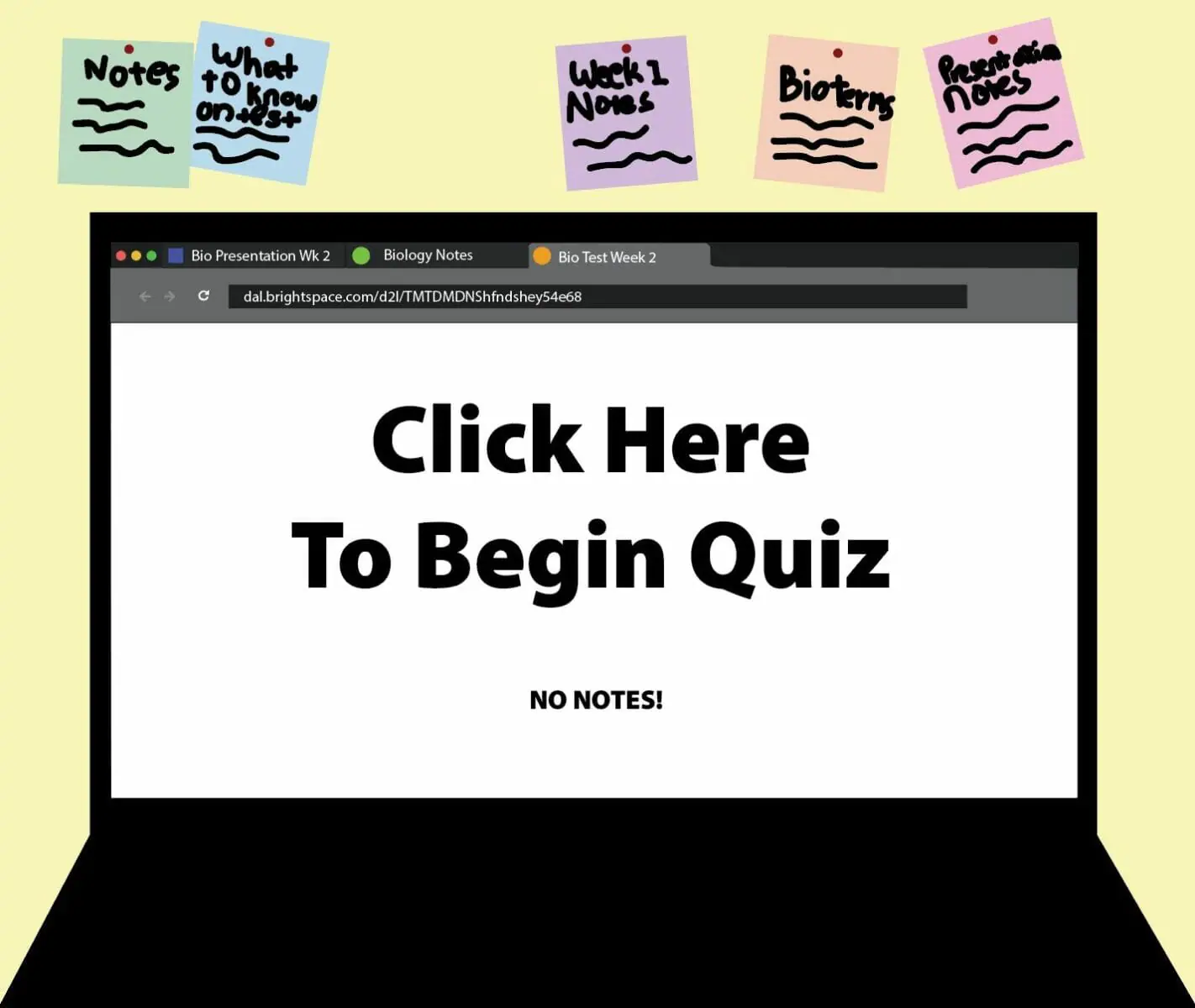During the COVID-19 pandemic, academic cheating skyrocketed, according to an August report from National Public Radio. Online learning allowed students to take digital shortcuts that were previously unavailable to them. With almost 80 per cent of Canadians vaccinated, we’ve been told to expect to be in classrooms for the foreseeable future. Will students see a change in grades without access to the online world?
Being stripped of online resources in asynchronous lectures makes me feel disempowered and confused about my approach to learning. I can’t pause lectures to research what the professor is talking about. I can’t skip past content I already know. It’s been hard to re-integrate into the classroom.
I lose focus quickly during lectures, but I can’t rewind the video. It feels foreign to contribute by talking rather than writing. Instead of mining documents for relevant information, I’m learning to absorb texts by reading them through.
For the second time in my life, I have to learn how to learn.
Digital tools during the COVID-19 pandemic
To achieve academic success, students must provide the correct answers on tests, essays and assignments. Before the COVID-19 lockdown, students got these answers one of two ways: by putting in the work, or through traditional cheating methods like cheat sheets, also known as crib sheets.
Lockdown changed all of this. Communication with professors was limited to 80-minute Zoom sessions and shoddy Wi-Fi detracted from peer conversations. It was hard to focus with classes consisting of computer screens and online modules. These screens became our classrooms during the pandemic. Most communication, learning and socializing for Dal courses happened in these digital spaces.
The pandemic caused a drop in grades and a rise in academic-related stress. The conditions did not facilitate learning but did facilitate cheating.
As the Gazette reported in October 2020, the pandemic caused widespread anxiety. Cory Williams, a fourth-year history and political science student at the time, told the Gazette, “It’s been rough,” Williams said in the Fall of 2020. “I’m relying solely on myself to succeed and I don’t have the same support systems I would have had if I was on campus.”
Growing up digital
Most college students have grown up in a digital age. Students are comfortable using computers and the internet to streamline everyday activities like banking, checking grades and chatting with friends. When these tools became the primary medium for education, we quickly learned the best digital shortcuts for other things.
Online learning led to new cheating methods, such as covert, student-to-student collaboration during exams, or idling course materials in a second window during closed book tests and keeping answers hidden off-screen. For a professor, these cheating methods are hard to identify and even harder to stop.
Some universities turned to software that monitored their students’ screens for them. The return to the classroom may offer teachers and administrators relief from the struggles of maintaining academic integrity on top of organizing an online teaching routine.
Back to class means less cheating
As the school year progresses, cheating rates will probably go down. This is unequivocally a good thing as cheating is proven to impede learning. If students find every answer online, there is no incentive to develop an understanding of different ideas. This devalues education and students won’t retain their education over time.
A return to academic integrity will make us all better students. That said, this return to in-person classes will probably cut too hard in the other direction.
As much as the pandemic fostered cheating, it also inspired students to discover new learning supports. Some strategies I began using include typing “CTRL+F” to quickly find important details after a thorough reading of a document, or using online searches to clarify a professor’s points during lectures.
The pandemic allowed me to speed up recorded lectures and process the content in half the time.
There are also classic tools, like SparkNotes, eNotes, EasyBib, Wikipedia, search engines and add-ons. Many of these supports can be used in classes where professors allow computers, but not all tools cross the barrier from online classes to in-person classes. YouTube tutorials, audio language translating apps and other helpful tools won’t make the cut. These all make classes easier by fast tracking tedious tasks and simplifying complex topics, but might be deemed disruptive.
Lectures will resume at regular speed with no ability to pause and resume. No more muting or ducking off camera to listen to the pronunciation of a word before being called upon in class, or watching video clips defining concepts being discussed.
Age gaps and iPods
There has always been something of a generational disconnect between teachers and students. The average student-professor age gap, in Canadian universities, is thirty-five years, according to 2017 data from Statistics Canada. An average third-year Dal student is younger than Google, iPods and Wikipedia. The average Canadian professor was a college student when the internet first launched.
I don’t blame professors for not fully grasping how vital the digital sphere is to the way our generation learns. However, I feel like my teachers have always harbored skepticism toward the internet.
Many teachers discourage Wikipedia as a resource. They often mandate the use of print resources for essays. It was probably difficult for teachers to be forced into an entirely digital environment and I empathize with this struggle.
Back in classes, students are now joining professors in the difficult process. In our current reintegration period devoid of digital shortcuts, grades may fall. As a consequence, traditional pen and paper cheating may even rise.
Finding equilibrium will be a long process, but if students and teachers move forward with understanding and empathy, I know we can survive it.


Recent Comments